Choosing the Right Dental Veneer Color: Factors to Consider
Dental Care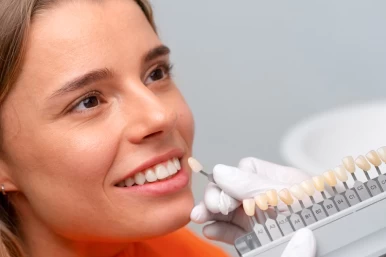
When considering the ideal "Hollywood smile," many individuals turn to dental veneers. These veneers offer a fast track to achieving a flawless smile, which takes just minutes to transform. Veneers are versatile and capable of addressing multiple dental concerns at once.
Choosing the right color for dental veneers is a crucial decision that can greatly impact the overall appearance of your smile. With a wide range of shades and tones available, it can be overwhelming to determine which color will best suit your natural teeth and facial features. Understanding the factors influencing the selection of veneer colors, such as skin tone, eye color, and personal preferences, is essential to achieving a harmonious and natural-looking result.
In this article, we will explore the key considerations to remember when choosing the color of dental veneers. Whether you are looking to brighten your smile or enhance its natural beauty, selecting the right veneer color is a crucial step in achieving a stunning and confident smile.
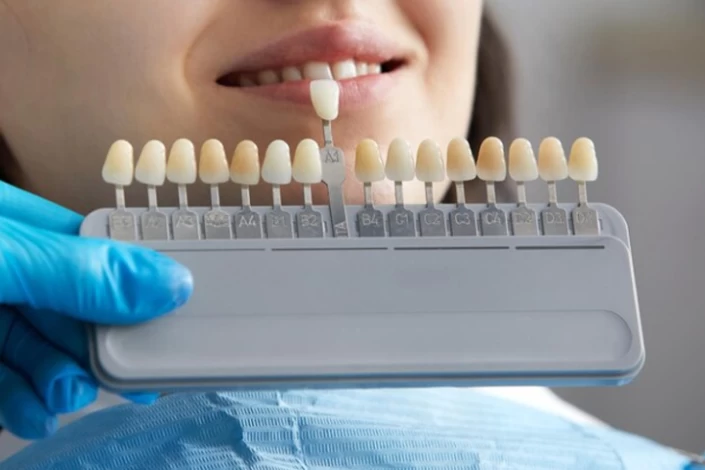
What Are Veneers?
Veneers are thin, custom-made shells of tooth-colored materials designed to cover the front surface of your teeth to improve their appearance. They are bonded to the front of the teeth, changing their color, shape, size, or length.
Veneers are typically made from either porcelain or resin composite. Porcelain veneers are more durable and stain-resistant. However, they require more tooth enamel to be removed before they can be placed. Resin composite veneers are less expensive and require less tooth removal, but they may not be as durable or stain-resistant as porcelain veneers.
Veneers can address various cosmetic dental concerns, such as chipped or cracked teeth, discolored teeth, misaligned teeth, gapped teeth, uneven teeth, and small teeth.
What Is the Veneers Shade Chart?
A veneers shade chart is a tool dentists and dental technicians use to help determine the appropriate color and shade of dental veneers for a patient's teeth. The shade chart typically consists of shades, from light to dark, that closely match the natural colors of teeth. The chart may also include variations in hue, saturation, and value to provide a comprehensive selection of colors that can be customized to suit individual preferences.
The shades on the chart are typically categorized based on the widely recognized Vita Classical Shade Guide, which assigns letters and numbers to specific shades. For example, the shades range from A (lightest) to D (darkest), with subcategories such as A1, A2, B1, B2, etc. Dentists use the shade chart to compare the color of a patient's natural teeth to the available veneer shades and select the most suitable match for a seamless and natural-looking result.
The five main categories of the veneers shade chart are:
- Reddish Brown (A);
- Reddish Yellow (B);
- Grey Colors (C);
- Reddish Grey (D);
- Bleach Shades (BL).
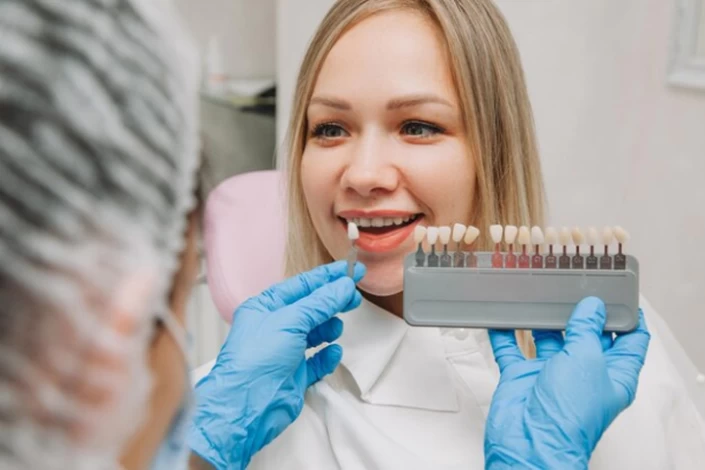
Some common dental veneer colors include:
- A1: Lightest natural shade, often called "bleach white."
- A2: Slightly darker than A1, a common choice for many people.
- A3: A warmer shade with slightly more yellow tones.
- B1: Bright white shade, often chosen for a whiter-than-natural look.
- B2: A common shade that closely matches natural teeth.
- B3: A slightly darker shade with more yellow undertones.
- C1: Light grayish shade, used for cooler-toned smiles.
- D2: Darker shade with more brown tones, suitable for individuals with darker natural teeth.
What Are the Steps in Choosing the Right Veneer Color?
Choosing the right veneer color involves several important steps to ensure that the final result complements your overall appearance and meets your aesthetic goals.
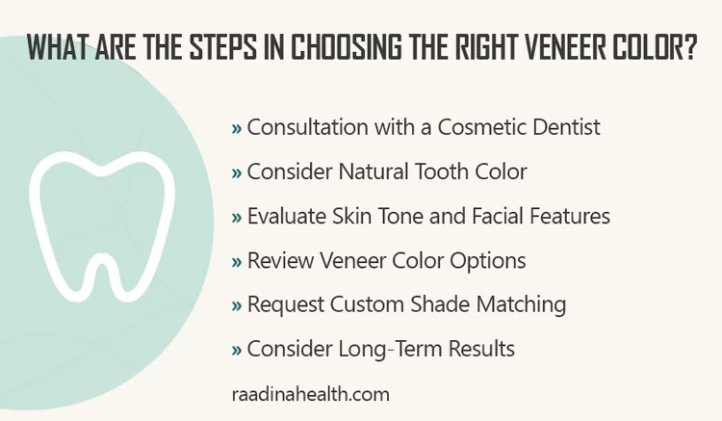
Here are the key steps in selecting the right veneer color:
Consultation with a Cosmetic Dentist;
Schedule a consultation with a cosmetic dentist who specializes in veneers. During this initial appointment, discuss your goals, concerns, and expectations regarding your smile makeover. Your dentist will assess your oral health, discuss treatment options, and help you determine the most suitable veneer color based on your skin tone, facial features, and natural tooth color.
Consider Natural Tooth Color;
Consider the color of your natural teeth when selecting a veneer shade. Your dentist may recommend matching the veneer color to your existing teeth for a seamless blend or choosing a slightly lighter shade to achieve a brighter, more uniform smile.
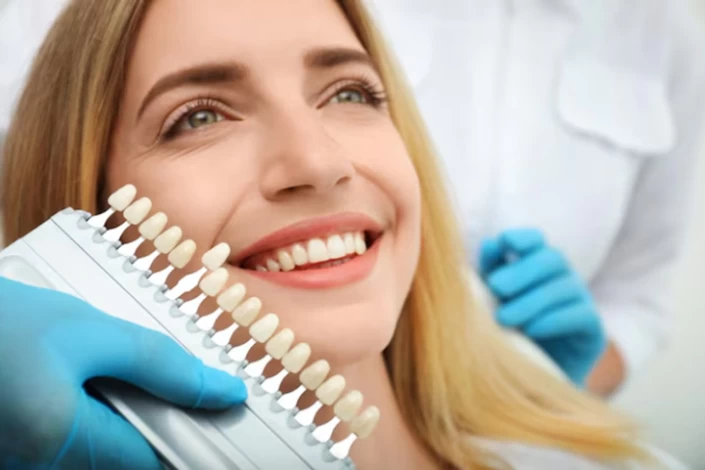
Evaluate Skin Tone and Facial Features;
Consider your skin tone and facial features when choosing a veneer color. Cooler tones may complement individuals with fair skin, while warmer tones may enhance the appearance of those with darker skin. Your dentist can guide you on selecting a veneer shade that harmonizes with your overall complexion and enhances your facial aesthetics.
Review Veneer Color Options;
Review different veneer color options, such as color charts or sample veneers, to visualize how each shade will look in your mouth. Your dentist may show you digital simulations or provide physical samples to help you decide the most suitable color for your veneers.
Request Custom Shade Matching;
Discuss this with your dentist if you have specific preferences or desire a customized shade. Custom shade matching can be achieved by collaborating with a dental laboratory to create veneers that precisely match your desired color and appearance.
Consider Long-Term Results.
Keep in mind that veneer color should not only look good initially but also maintain its appearance over time. Choose a shade resistant to stain and discoloration to ensure long-lasting results and a beautiful smile for years.
How to Choose Veneer Color?
When selecting a veneer color, it is essential to consider various factors to ensure a successful outcome and lasting satisfaction. These factors include:
Facial Features
Your facial features are crucial in determining the most suitable shape of veneers. While they do not dictate the color choice, they can help guide you toward a veneer shape that complements your natural features. For instance, individuals with round faces may find longer veneers more flattering, while those with oval-shaped faces may benefit from square veneers to enhance facial balance.
Age and Gender
Consider your age when choosing veneer shades. Younger individuals may opt for brighter shades, while older individuals might prefer darker shades due to teeth naturally yellowing with age. As you age, changes in tooth structure occur, such as shortening and flattening from wear, resulting in narrower smiles overall. Color preferences vary by gender, with women often favoring lighter shades and men leaning towards slightly darker ones. However, no strict rules are based on age or gender, so select the shade that enhances your unique appearance.

Natural Tooth Color
Choose a veneer shade that closely matches your natural teeth to achieve a natural look. Compare your teeth to a veneer shade chart at your dentist's office to find the closest hues. Avoid extremes of lightness or darkness, as overly light veneers can appear artificial, while dark ones may make teeth look discolored.
Skin Tone
Take your skin tone into account when selecting a veneer shade. Fair-skinned individuals may find slightly darker shades more flattering, whereas those with darker complexions should opt for neutral tones to complement their natural coloring.
Veneer Sizes
In addition to color and shade, the size of your veneers is crucial. The shape and size of your teeth play a significant role in determining whether you need small or large veneers for a seamless look. Small veneers work well for narrow smiles, while larger ones can help close gaps between teeth and create uniform tooth length. Sometimes, your dentist may need to decide based on your specific dental needs.
Number of Veneers
When receiving a larger number of veneers, such as eight or ten on both the upper and lower jaws, a wide range of colors can be considered. However, the situation changes when opting for four veneers or fewer. In such cases, the color options may be more limited, and the dentist may need to select a shade that closely matches your natural teeth.

The Color of Your Sclera
A general guideline suggests using the whites of your eyes (sclera) as a reference point when selecting veneer colors. This is because the teeth and eyes are prominent facial features. Therefore, choosing a veneer shade that harmonizes with the color of the sclera may be a favorable choice.
Personality
If you are an extrovert who enjoys being in the spotlight, choosing brighter teeth colors should not pose a problem as you are comfortable with attention. A whiter smile naturally draws notice, so it's important to openly discuss your preferences with your dentist to ensure the chosen shade truly reflects your personality.
Lighting Conditions
Consider how the color of your veneers will appear in different lighting conditions, such as natural light, indoor lighting, or flash photography. Your dentist can help you choose a natural and attractive shade in various settings.
Personal Preference
Ultimately, your preference plays a significant role in selecting the color of your veneers. Choose a shade that makes you feel confident and happy with your smile transformation.
Why Veneers in Iran?
With a focus on achieving aesthetic perfection and patient satisfaction, dental veneers in Iran offer a compelling combination of quality, affordability, and exceptional results, making it a preferred destination for individuals seeking cosmetic dental enhancements.
Iranian dentists are known for their expertise in cosmetic dentistry and meticulous attention to detail when crafting dental veneers. Patients seeking dental veneers in Iran can expect top-notch treatment using the latest technology and materials to achieve natural-looking and long-lasting results. The affordability of dental veneers in Iran compared to Western countries is also significant in attracting patients worldwide.
FAQs About Choosing Tooth Veneer Color
What is the most popular veneer color?
Most individuals choose shades that closely mimic the appearance of natural teeth. Examples of these shades include A1 (a light yellowish-white), A2 (a slightly darker shade with added warmth), and B1 (a vibrant white). These tones typically harmonize effortlessly with one's current teeth, creating a radiant smile.
What color veneers do celebrities have?
Celebrities often opt for bright white and highly reflective veneers, giving them a dazzling and glamorous smile. Many celebrities choose shades like BL1 (a brilliant white) or BL2 veneers (a slightly warmer white) to achieve a striking, eye-catching look. These shades can make teeth appear whiter and more uniform, creating a Hollywood smile that stands out on the red carpet.
My veneers are not white enough. What is the problem?
Suppose your veneers are not as white as you'd like. In that case, factors such as the natural color of your teeth, the shade selection of the veneers, potential staining, the thickness of the veneers, and the quality of the materials used could contribute to the issue.
What is the whitest shade of dental veneer?
The whitest shade of dental veneer is typically called "bleach white" or "snow white". This shade is often the brightest and most vibrant white available for veneers, giving the teeth a very bright and luminous appearance.
What is the difference between composite and porcelain veneers in color?
Porcelain veneers are more resistant to staining and offer a more natural appearance than composite veneers. Porcelain veneers can be customized to match the color of your natural teeth or achieve a brighter shade for a whiter smile.
Can I change the color of my veneers later if I'm not satisfied?
While it is possible to change the color of your veneers, it is best to communicate your preferences and expectations with your dentist before the treatment. This can help ensure you are satisfied with the final result and avoid unnecessary changes later.
Will my veneers stain over time?
Choosing a stain-resistant veneer material, such as porcelain, can help minimize the risk of discoloration. Your dentist can recommend the best material and shade to maintain the longevity and aesthetics of your veneers.
How do I ensure that the chosen veneer color matches my natural teeth seamlessly?
Your dentist will carefully match the veneer color to your natural teeth using a tooth shade guide and other tools. They may also consider clarity, texture, and surface characteristics to seamlessly blend the veneers and your natural teeth.
How do I choose the right dental veneer color for my smile?
The right veneer color depends on factors like your natural tooth shade, skin tone, eye color, and personal preference. A cosmetic dentist usually uses a shade guide to help you find a balance between brightness and a natural look.
Can veneers look too white or fake?
Yes, if the veneer color is too bright compared to your natural features, it may look artificial. That’s why dentists often recommend a slightly softer shade than the whitest option for the most natural appearance.
Do veneer colors change over time?
High-quality porcelain veneers resist staining and do not change color, but the surrounding natural teeth can discolor. Regular cleaning and avoiding stain-causing foods or smoking help maintain a uniform look.
What’s the difference between Hollywood white and natural white veneers?
Hollywood white veneers are ultra-bright and often chosen by celebrities, while natural white veneers are slightly softer in shade, blending more seamlessly with natural teeth. The choice depends on whether you want a glamorous or subtle smile.

No reviews
Your comment